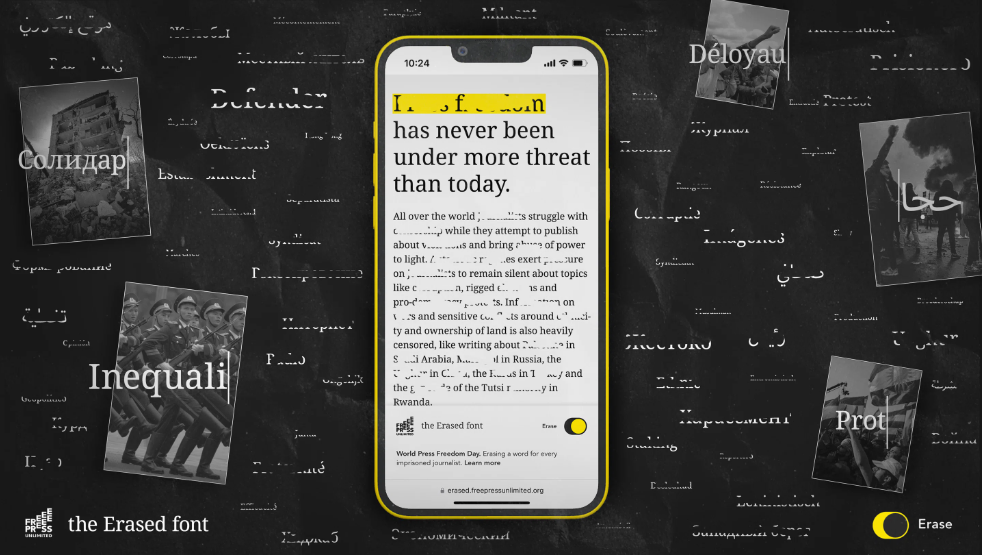Fight press censorship with an erasable font plus...6 more fab font campaigns.

Creatives and designers love fonts more than kids love chocolate. So, it’s no surprise that they muscled their way into the creative advertising toolbox. This fab collection of campaigns shows how brands have used fonts as visual metaphors, innovative means to raise donations, storytelling devices, or in the case of IKEA how to tap into existing user behaviour for fun and profit.
Erased Font | Free Press Unlimited | Amsterdam 180 | 2023

In 2022, the global imprisonment of journalists reached 363, marking a staggering 296% increase since 2000. This estimation, however, fails to capture the full extent of the problem due to underreporting. To address this issue, creative agency 180 Amsterdam, in collaboration with Free Press Unlimited and Wonderland, developed the Erased font; a font that replaces one word for each imprisoned journalist, symbolizing censorship. The erased words connect to real reporters and their past topics. To safeguard identities, imprisoned journalists' names aren't disclosed, but their countries are shown. The campaign, launched on World Press Freedom Day, urges news publications to adopt the font to connect readers with the silenced journalists' work. The font is accessible on GitHub and will be updated annually to reflect the rising number of silenced journalists.
Fonts For Freedom | Reporters Without Borders | Serviceplan | 2019
In a similar theme, this campaign by Serviceplan Hamburg was a response to the increasing censorship and closures of media organisations worldwide. In partnership with Reporters Without Borders, Serviceplan created Fonts for Freedom, a campaign transforming banned newspaper fonts into symbols of press freedom. Typography experts reconstructed the house fonts of nine prohibited newspapers from oppressive regimes in Turkey, Azerbaijan, Vietnam, Cambodia, Tanzania, Hungary, and Russia. The campaign garnered attention when billboards featuring headlines set in the banned fonts confronted Turkish President Erdoğan during his visit to Germany. Fonts for Freedom reached 132 countries, generating 830 million contacts and 2.7 million interactions, elevating the fight for press freedom through typographic activism.
Climate Crisis Font | Helsingin Sanomat | TBWA\ | 2021
For many, the climate crisis is hard to visualise, which leads to apathy and a lack of change. To help people see the pressing nature of the crisis, Finnish newspaper Helsingin Sanomat began using the Climate Crisis Font in place of its standard typeface. The OpenType font has variable weight adjustment. The font diminishes in size and boldness from the 1979 variant to the 2050 one – showing the damage that will be done to the ice if solutions aren’t in place. The campaign hijacks something people see daily, turning it into a useful message calling for change.
Soffa Sans | IKEA | Proximity London | 2020
In their quest to uncover the hidden creativity within IKEA's endeavors, Proximity London stumbled upon a group of individuals who were playfully subverting IKEA's 'Design your own sofa' planning tool. Taking advantage of the unlimited configurations without cost functionality, these creative individuals crafted unconventional sofa designs featuring spirals, labyrinths, and even phallic shapes. In response, Ikea collaborated with digital agency Proximity London to develop Soffa Sans. Touted as "the world's comfiest font," it was constructed from 38 unique sofa configurations. The impact was remarkable, as Soffa Sans garnered a staggering 84.2 million impressions and received over 13,000 mentions on social media within just 48 hours. The tool itself experienced a 6,695% increase in organic traffic, and users spent an average of 1,023% more time engaging with it!
The Fading Font | Alzheimer's Association | McGarryBowen | 2018
At the time of the campaign, China was (and probably still is) home to the highest number of Alzheimer's patients globally and the country faces a significant lack of awareness and understanding regarding the disease's symptoms. To address this issue, McgarryBowen Shanghai developed the Fading Font—a custom-designed set of Chinese characters with gradually fading strokes, mirroring the gradual loss of memories caused by Alzheimer's. This innovative font comprised around 7,000 commonly used Chinese characters and was made available as a free tool on World Alzheimer's Disease Day. By using the font, people gained a glimpse into the experience of living with this disease. The font was downloaded over 130,000 times, becoming the top trending topic on Sina Weibo. More than 100 brands and celebrities joined the campaign, resulting in a remarkable total reach of almost 235 million.
Homeless Fonts | Arrels Foundation | 2014+
Homelessfonts is an initiative by the Arrels Foundation to support the life of homeless people in Barcelona. Their aim was to create new fonts from the calligraphy of homeless people from Barcelona. Each of the fonts was carefully digitized from the handwriting of twelve homeless people who agreed to participate. They received calligraphy workshops and practiced with typographic exercises, to create their own font; a font with soul. Furthermore, a biography of each person captures their story to help raise awareness and bring some dignity to the life of the homeless living on the streets of Barcelona. Any designer, business, or individual can buy these fonts to use in their designs, posters, branding, etc - with all money raised donated to the Arrels Foundation.
The Font Of Kindness | Rosbank | Smetana | 2020
In Russia, there is a pressing need for therapy among thousands of children living with cerebral palsy. To help, Rosbank in partnership with its agency Smetana gathered handwriting samples from 33 children with cerebral palsy and crafted a unique Font of Kindness. This font was made available to everyone on World CP Day as a means to show support for these children. Through the project website, visitors had the opportunity to download the font, contribute donations, and purchase merchandise. Within a single day, the font spread like wildfire throughout the entire country, reaching over 30 million people. The campaign successfully raised 11.5 million rubles, which in turn provided assistance to more than 130 children with cerebral palsy.
